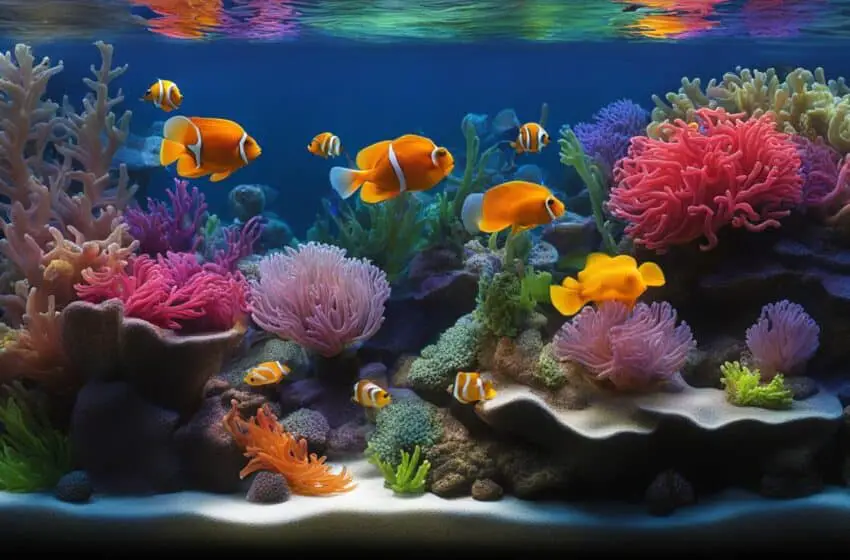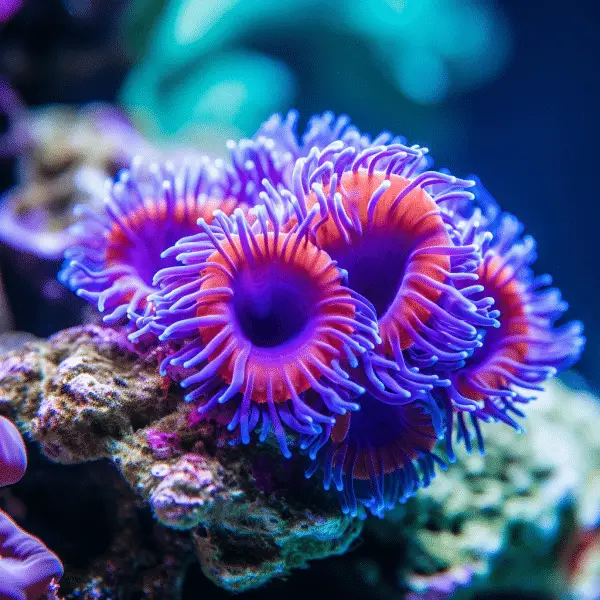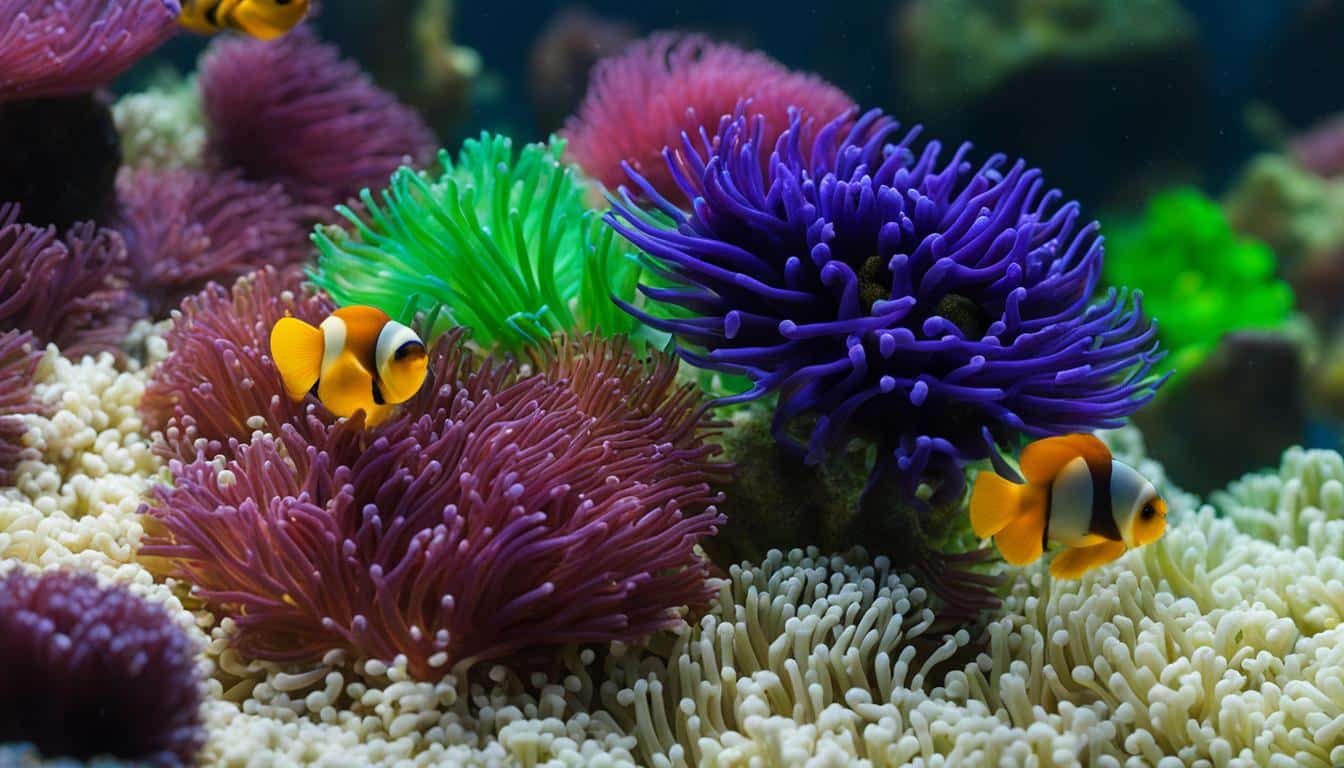Exploring Saltwater Aquarium Anemone Species: Your Complete Guide

Saltwater aquariums provide a beautiful and rewarding addition to any home, but caring for them requires specific attention to detail. Anemones are a popular choice for adding color and life to saltwater aquariums, but they can be challenging to care for. In this comprehensive guide, I will explore six different types of saltwater aquarium anemones suitable for various skill levels. I will also discuss the care requirements for maintaining a healthy anemone in your aquarium, including lighting, water parameters, and compatibility with other tank inhabitants.
Key Takeaways:
- Saltwater aquarium anemones can add vibrant colors and life to your tank.
- There are different types of anemones suitable for various skill levels.
- Proper care includes providing adequate lighting, stable water parameters, and compatible tank mates.
- Beginner-friendly anemones are available for those new to saltwater aquariums.
- Colorful anemone species can enhance the aesthetic appeal of your aquarium.

Understanding Anemones: What They Are and How to Care for Them
Anemones are fascinating invertebrates that add beauty and diversity to saltwater aquariums. Understanding their unique characteristics and providing proper care is essential for their well-being in your tank. Let’s explore what anemones are and how to care for them.
Anemones are closely related to jellyfish and corals. They have a soft, cylindrical body with a sticky foot used for attachment and a ring of tentacles around the mouth for capturing prey. These creatures can vary in size, shape, and color, offering an array of options for aquarium enthusiasts.
When caring for anemones in your saltwater aquarium, there are several important factors to consider. Firstly, they require a stable environment with consistent water parameters. This includes maintaining proper temperature, salinity, and pH levels. Regular testing and adjustments are necessary to ensure an ideal habitat for your anemones.
Additionally, anemones need strong lighting to support their photosynthetic symbiotic algae, which provide them with energy. It’s crucial to provide adequate light intensity and spectrum for their specific needs. Furthermore, water flow and quality should be carefully managed to mimic their natural habitats and prevent stagnant conditions.
Table: Anemone Care Requirements
| Care Aspect | Details |
|---|---|
| Water Parameters | Temperature: 75-80°F; Salinity: 1.023-1.025; pH: 8.1-8.4 |
| Lighting | High-intensity LED lighting or T5 fluorescent bulbs |
| Water Flow | Moderate to strong flow, mimicking natural ocean currents |
| Feeding | Supplemental feedings with meaty foods like shrimp, fish, and mysis shrimp |
| Compatibility | Consider tank mates that won’t harm or stress the anemone |
When introducing anemones to your aquarium, it’s important to acclimate them slowly to prevent stress and ensure a smooth transition. Proper quarantine and quarantine protocols can help prevent the introduction of diseases or parasites to your existing tank inhabitants.
Anemones move a lot, so make sure there’s enough room and secure rockwork to avoid hurting other things. Some types can sting, so be careful when handling or adding them to your tank.
By understanding the unique needs of anemones and providing a suitable environment, you can enjoy the beauty and vitality they bring to your saltwater aquarium. Remember to research specific species, consult with experienced hobbyists, and monitor water parameters regularly to ensure the health and longevity of your anemones.
Top Six Anemones for Saltwater Aquariums
With anemones, your saltwater aquarium may be vibrant. The species you chose must fit your tank and upkeep needs. These top six saltwater aquarium anemones will help you choose:
Carpet anemones are vibrant and large and they add life to saltwater tanks. To keep them happy, it’s important to have a well-planned aquarium with hiding spots and adequate lighting.
Bubble Tip Anemone (Entacmaea quadricolor) Bubble tip anemones are popular saltwater aquarium anemones due to their bright colors and bubble-like tips. They have several clownfish and are beginner-friendly.
Aquarists appreciate Rock Flower Anemones (Epicystis crucifer) for their colors and patterns. Moderate lighting and peaceful tankmates suit them.
Long Tentacle Anemone (Macrodactyla doreensis)—Its long, flowing tentacles enhance any tank. Tanks with low water flow and dim lighting suit them.
Saltwater aquariums look great with colorful and long tentacled sebae anemones. Large tanks and strong lights are needed. Only their tentacles are exposed when tube anemones bury. To reveal their hues, they need sandy bottom and moderate lighting.
Research.
Check each species’ compatibility with your tank’s residents and care needs. Giving your anemones the right atmosphere and care will help them thrive and beautify your saltwater tank.
| Anemone Species | Lighting Requirements | Water Flow | Tank Size | Compatibility |
|---|---|---|---|---|
| Carpet Anemone | Strong | Moderate | Large | Peaceful tank mates |
| Bubble Tip Anemone | Moderate to strong | Moderate | Medium to large | Clownfish (various species) |
| Rock Flower Anemone | Moderate | Low | Small to medium | Peaceful tank mates |
| Long Tentacle Anemone | Low to moderate | Minimal | Medium to large | Peaceful tank mates |
| Sebae Anemone | Strong | Moderate | Large | Peaceful tank mates |
| Tube Anemone | Low to moderate | Low to moderate | Medium to large | Peaceful tank mates |
Table: Comparison of top six anemone species for saltwater aquariums, highlighting their lighting requirements, water flow preferences, tank size recommendations, and compatibility with other tank mates.

Conclusion
Anemones can add breathtaking beauty to your saltwater aquarium, but they require careful care and attention. By understanding the specific needs of these fascinating creatures, you can create a thriving home for them in your tank.
When selecting anemones for your saltwater aquarium, consider the species that are best suited for your skill level and tank setup. Some species, like the colorful Bubble Tip Anemone (Entacmaea quadricolor) or the hardy Rock Flower Anemone (Epicystis crucifer), are great choices for beginners. Others, such as the magnificent Carpet Anemone (Stichodactyla gigantea) or the intricate Flower Anemone (Phymanthus crucifer), require more advanced care and experience.
To ensure the well-being of your anemones, maintain stable water parameters, provide proper lighting, and offer ample hiding places and suitable food sources. Regular water testing and quality filtration are essential for creating a healthy environment. Remember that anemones can be toxic and have the potential to move around in the tank, so take precautions to protect both the anemones and other tank inhabitants.
By following these guidelines and incorporating the right anemones into your saltwater aquarium, you can create a vibrant underwater world that showcases the beauty and diversity of these captivating creatures. Enjoy the wonder and serenity they bring to your home.
FAQ
Can I keep anemones in my saltwater aquarium if I’m a beginner?
Yes, there are beginner-friendly anemones that are suitable for saltwater aquariums. However, it is important to research and understand the specific care requirements for each species before adding them to your tank.
Do anemones require a specific type of lighting?
Yes, anemones require strong lighting to thrive in a saltwater aquarium. It is recommended to provide them with high-intensity lighting, such as metal halide or LED lights, to ensure they receive the necessary amount of light for photosynthesis.
How can I maintain stable water parameters for my anemone?
To maintain stable water parameters, it is crucial to regularly test the water quality in your aquarium and make appropriate adjustments. You should monitor and maintain proper levels of temperature, salinity, pH, ammonia, nitrite, and nitrate. Regular water changes and the use of high-quality filtration systems can also help maintain a stable environment.
Can anemones be kept with other tank inhabitants?
Anemones can coexist with other tank inhabitants, but compatibility should be carefully considered. Some fish, such as clownfish, have a natural symbiotic relationship with anemones and can serve as suitable tank mates. However, not all anemones will host clownfish, and some tank inhabitants may harm or be harmed by anemones. It is essential to research compatibility before introducing anemones to your aquarium.
Are anemones toxic to other tank inhabitants?
Yes, anemones can be toxic to other tank inhabitants. Some species of anemones have stinging cells called cnidocytes that can release toxins. While they generally do not pose a significant threat to larger fish, anemones can harm or kill smaller or more delicate tank inhabitants. It is crucial to consider the size and behavior of the other inhabitants in your tank when deciding to keep anemones.
Can anemones move around in the tank?
Yes, some species of anemones are capable of moving around the tank. This movement can be caused by various factors, such as inadequate lighting, unfavorable water conditions, or the search for a more suitable location. It is important to provide anemones with a stable environment and adequate space to prevent excessive movement that may harm themselves or other tank inhabitants.



